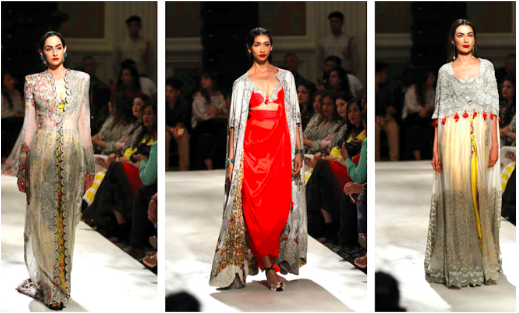Unveiling the Rich Heritage of Eastern Fashion
Discovering the complex tapestry of Eastern fashion reveals a world where practice fulfills advancement, and workmanship intertwines with social importance. From the opulent silks of ancient empires to the detailed embroidery of nomadic people, each garment narrates that goes beyond time and borders, resembling the rich heritage and imaginative legacy of the East. As we peel off back the layers of background and practice, an interesting journey waits for, untangling the tricks behind the fascinating attraction and enduring influence of Eastern fashion on the worldwide stage.
Beginning of Eastern Style

In Mesopotamia, for instance, the Sumerians and Babylonians produced garments utilizing bed linen, woollen, and natural leather, embellished with elaborate patterns and jewelry. Old Egyptians are renowned for their innovative weaving skills and the usage of light-weight, breathable textiles like linen. Chinese fashion emphasized the relevance of shade symbolism and complex embroidery techniques, while Indian garments included vivid colors, lavish materials like silk and cotton, and intricate drape designs such as the saree.
These ancient human beings not only affected each other yet also paved the method for the culturally rich and varied tapestry that is contemporary Eastern style. With centuries of development, Eastern fashion remains to grow, blending practice with modern influences to develop ageless and one-of-a-kind designs.
Cultural Influences and Practices
Attracting from centuries-old personalizeds and beliefs, social influences and traditions play a pivotal duty fit the significance of Eastern style (eastern wear pakistan). The rich tapestry of cultures throughout Eastern areas such as Asia, the Middle East, and Africa has heavily influenced the garments styles, colors, fabrics, and designs that are prevalent in Eastern fashion today
In nations like India, Japan, and China, traditional garments like sarees, cheongsams, and bathrobes continue to hold significant cultural importance and are commonly decorated with elaborate needlework or symbolic patterns that show ingrained beliefs and values. Likewise, in Center Eastern countries, the moving abayas and kaftans used by males and females not just serve as modest clothes however also show the area's social heritage and Islamic practices.
Moreover, using details colors like red forever luck in Chinese society or detailed geometric patterns motivated by Islamic architecture better exemplify how cultural influences manifest in Eastern fashion - eastern wear pakistan. By recognizing and preserving these cultural influences and customs, Eastern fashion proceeds to evolve while remaining real to its rich heritage
Advancement of Eastern Attire
In time, Eastern garments have actually gone through significant makeovers, mirroring a blend of tradition and modernity in their design and design. Typical Eastern garments such as the saree, hanbok, kimono, and salwar kameez have actually developed to incorporate modern aspects while protecting their cultural essence.
One remarkable development is the usage of cutting-edge materials and strategies in Eastern garment building and construction. Standard handwoven textiles like silk and cotton have actually been matched with modern products such as polyester and blends, supplying boosted resilience and convenience of treatment. Furthermore, innovations in printing modern technologies have actually enabled elaborate patterns and layouts to be included right into Eastern garments with precision and information.
Furthermore, modifications in shape and tailoring have actually improved Eastern clothes, making them extra functional and ideal for diverse celebrations. Typical dress codes have loosened up, allowing for testing with decorations, designs, and shades. This development has not just made Eastern garments much more enticing and accessible to a worldwide target market however has additionally ensured their continued significance in contemporary style landscapes.
Meaning in Eastern Clothing
Discovering the deep-rooted social value woven into Eastern clothes unveils an abundant tapestry of meaning and practice. Eastern garments are typically imbued with signs that reflect the wearer's social status, faiths, and cultural identity. In several Eastern cultures, the color red represents good luck and success, making it a preferred selection for wedding event clothes. Elaborate needlework patterns can communicate stories of folklore or stand for true blessings for the wearer.
Furthermore, certain garments hold symbolic meanings. Its layout, material, and also the method it is worn all carry deep social relevance.

Effect of Eastern Style Today

The consolidation of Eastern elements in Western fashion has caused this link a blend of styles that deal with varied preferences and choices (eastern wear pakistan). Developers typically draw inspiration from Eastern materials, shapes, and patterns, producing unique and cutting-edge items that blend conventional and contemporary looks. This cross-cultural exchange has not only revitalized the apparel industry yet likewise promoted a much deeper admiration for Eastern heritage and craftsmanship
Moreover, the rise of electronic systems and social media has further magnified the influence of Eastern style, permitting designers and brand names to get to a broader audience and display their cultural heritage to the globe. With collaborations, style programs, and on the internet projects, Eastern fashion proceeds to prosper and evolve in today's interconnected and dynamic worldwide landscape.
Final Thought
In final thought, the rich heritage of Eastern fashion is a testament to the cultural influences, elaborate craftsmanship, and profound significance embedded in each garment. From ancient human beings to modern interpretations, Eastern fashion proceeds to mesmerize with its distinct mix of practice and technology. The impact of Eastern fashion today functions as a suggestion of the timeless elegance and artistic expression that have made it an international phenomenon commemorated for its abundant cultural heritage.
Checking out the complex tapestry of Eastern fashion introduces a globe where tradition meets innovation, and craftsmanship intertwines with cultural significance.The withstanding significance and social relevance embedded in Eastern attire continue to shape and influence the modern influence of Eastern style today. Eastern fashion has actually gone beyond borders, coming to be an international phenomenon welcomed by developers, stars, wikipedia reference and fashion fanatics worldwide.In final thought, the abundant heritage of Eastern fashion is a testimony to the cultural influences, complex workmanship, and profound importance embedded in each garment. The influence of Eastern fashion today serves as a suggestion of the timeless beauty and imaginative expression that have actually made it a worldwide sensation commemorated for its abundant more helpful hints cultural heritage.